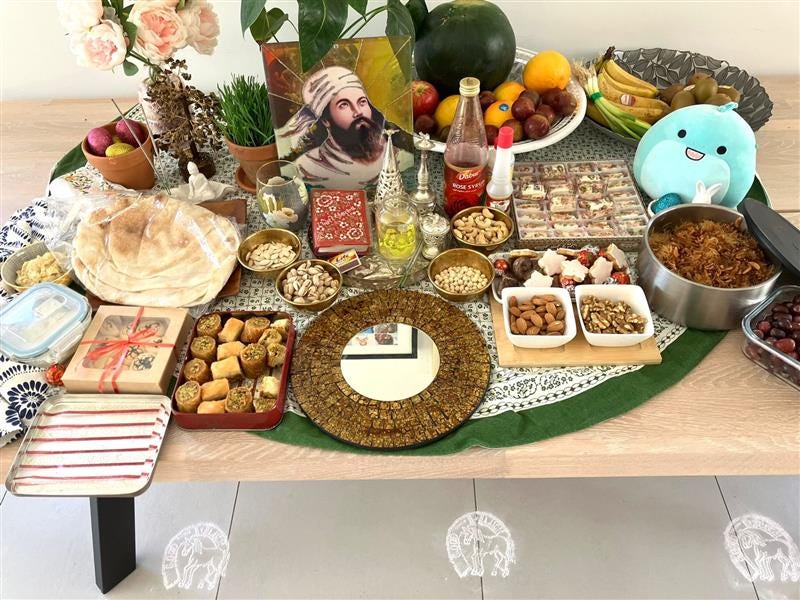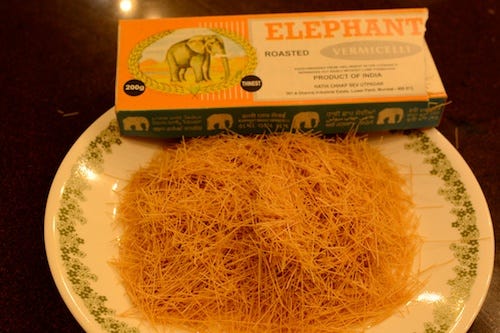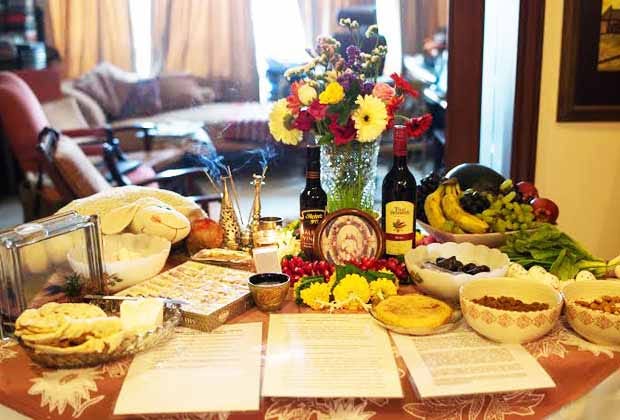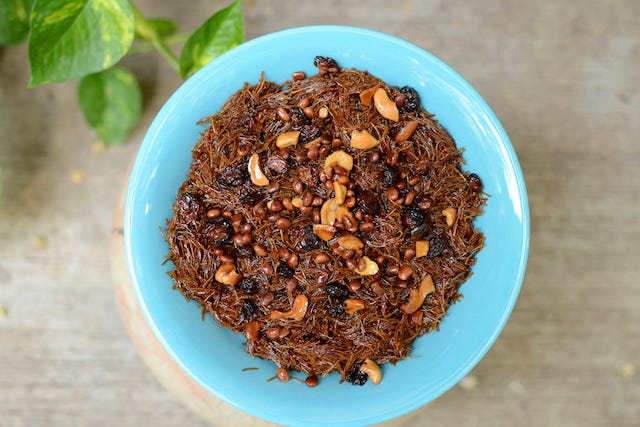Celebrating spring in autumn
Enjoying a 'new year' every three months, always with sweet Sev (vermicelli)
Mic drop moment alert. My favourite part about being Indian is not the food.
While food comes a close second, what I love most about being Indian is the permission to celebrate a “new year” at least once every three months.
As a Parsi Zoroastrian, I regularly celebrated the “new year” once in March when our Iranian ancestors celebrate Nowruz and once in August when the Parsi calendar changed. We also enjoyed celebrating Diwali in October and then the actual New Year with the rest of the world.
The Zoroastrian New Year, we celebrated in much the same way: cleaning the house a week prior, buying new clothes, visiting the fire temple in the morning, watching a slapstick-style Gujarati play in the evening, and then having a hearty dinner of fish, chicken and mutton all in the same meal.
It wasn’t until I got married and Mum lightly suggested (read, insisted) I setup my own Haftsin table did I truly understand what celebrating Nowruz was about.

Nowruz is the name of the Persian new year, and it consists of two words: ‘now’ or ‘no’ meaning ‘new’ and ‘ruz’ or ‘rooz’ meaning ‘day’, which when put together means ‘new day’. It’s a celebration dating back 3500 years that marks the spring equinox and the start of spring in the Northern Hemisphere.
While Nowruz is deeply rooted in Zoroastrianism (the predominant religion in Iran thousands of years ago), the celebration is not connected to any religion today. It is widely celebrated across Iran, its neighbouring countries and worldwide amongst Zoroastrians.
At its core, Nowruz is about celebrating the victory of good over evil. We do this by celebrating the first day of spring as the light and warmth of the season conquers the cold and dark of winter.
Except there’s a tiny problem. Living in New Zealand, Nowruz to me, signals the beginning of winter. Leading up to the day, the mornings are dark, the air crispy cold and without me realising it, my soul starts carrying around a sense of impending gloom. Soon, our long sunny evenings will be gone, and it will be time to hibernate (but not really as NZ has zero public holidays through the winter!).
Why celebrate spring in autumn then?
The answer is simple. Because we can.
As a question-everything teenager, I rebelled against the fuss of Nowruz. “Why mark the period when the dark is clearly winning over the light?”, I’d whine. On reflection, most of my resentment stemmed from being bossed around to clean the house. In reality, I love celebrating Nowruz because there’s something magical about participating in a tradition 3500 years in the making. And because it’s always a good time to pause, take stock of the good things in life and celebrate with family.
My favourite part about celebrating Nowruz is the Haftsin table
A ceremonial table laden with fruit, food and flowers showcasing the 7 ‘S’s—seven items starting with the letter ‘s’ in Persian, each symbolising hope, renewal and prosperity for the coming year. On a typical Haftsin table, you will find:
Sabzeh – sown wheat to mark the rebirth of nature
Samanu – sweet pudding for the sweet moments of life
Sib – red apples for beauty
Sikkeh – coins for wealth and prosperity
Seer – garlic as medicine and good health
Sumac – the bright red spice for the spice in life
Serkeh – vinegar for old age and patience
We also have a mirror for self-reflection, candles for light, eggs for fertility and nuts for love. Each family will lay out this table together and it can be laden with food or a simple offering you setup for a day.
Then, at the exact moment of Nowruz, we light the candles, take a moment to reflect and give thanks—and finally, celebrate together by feasting on the food we jointly lay out. Over the next three to five days we also visit each other’s Haftsin tables to celebrate friendships, exchange gifts for the new year and eat our way through all the food.
As I become more comfortable in my identity as a Kiwi-Indian of Iranian descent who follows Zoroastrianism, Nowruz is no longer the weird spring festival my mum forces me to celebrate in autumn. I invite my Kiwi friends, neighbours and everyone in my life to feast with me at my Haftsin table. Last year I invited clients from my small business to pay their respects and the table and join me for a lunch and this year, I took Nowruz to work and together, we put together a shared lunch with items made from the seven S/Sh’s.
Since January is long over, I even made a new resolution. After all, I only need to follow until Matariki (the Māori New Year) rolls around.
One of the things we always make at Nowruz is Sev.
Go to a Parsi household on any auspicious day and you will always find a bowl of Parsi Sev which is traditionally served with sweet cardamom-laced yoghurt. Made from roasted vermicelli and topped with fried raisins, cashews and almonds, this sweet treat can be had for breakfast, lunch, dinner or tea-time or any other time that the tummy growls.

My mum is the resident Sev expert and she’s always cautioning me that while Sev only needs water and sugar, the one ingredient needed in abundance is patience. Hurry while making Sev and you risk it turning into a sticky lump or what we Parsis call ‘Londo’.

Under her strict tutelage, I’ve been practising my Sev-making skills and I’ve graduated from ‘Londa jevi Sev’ to reasonably okay. The good news is that even if yours turns out to be a sticky lump, it will taste bloody awesome so you should make it regardless!
Keep reading with a 7-day free trial
Subscribe to Beyond Butter Chicken to keep reading this post and get 7 days of free access to the full post archives.





